(优选)语言文化与翻译
- 格式:ppt
- 大小:332.50 KB
- 文档页数:15
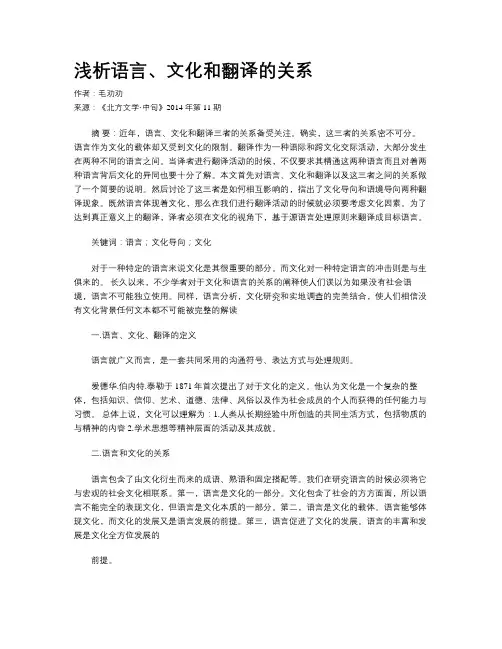
浅析语言、文化和翻译的关系作者:毛劝劝来源:《北方文学·中旬》2014年第11期摘要:近年,语言、文化和翻译三者的关系备受关注。
确实,这三者的关系密不可分。
语言作为文化的载体却又受到文化的限制。
翻译作为一种语际和跨文化交际活动,大部分发生在两种不同的语言之间。
当译者进行翻译活动的时候,不仅要求其精通这两种语言而且对着两种语言背后文化的异同也要十分了解。
本文首先对语言、文化和翻译以及这三者之间的关系做了一个简要的说明。
然后讨论了这三者是如何相互影响的,指出了文化导向和语境导向两种翻译现象。
既然语言体现着文化,那么在我们进行翻译活动的时候就必须要考虑文化因素。
为了达到真正意义上的翻译,译者必须在文化的视角下,基于源语言处理原则来翻译成目标语言。
关键词:语言;文化导向;文化对于一种特定的语言来说文化是其很重要的部分。
而文化对一种特定语言的冲击则是与生俱来的。
长久以来,不少学者对于文化和语言的关系的阐释使人们误以为如果没有社会语境,语言不可能独立使用。
同样,语言分析,文化研究和实地调查的完美结合,使人们相信没有文化背景任何文本都不可能被完整的解读一.语言、文化、翻译的定义语言就广义而言,是一套共同采用的沟通符号、表达方式与处理规则。
爱德华.伯内特.泰勒于1871年首次提出了对于文化的定义。
他认为文化是一个复杂的整体,包括知识、信仰、艺术、道德、法律、风俗以及作为社会成员的个人而获得的任何能力与习惯。
总体上说,文化可以理解为:1.人类从长期经验中所创造的共同生活方式,包括物质的与精神的内容2.学术思想等精神层面的活动及其成就。
二.语言和文化的关系语言包含了由文化衍生而来的成语、熟语和固定搭配等。
我们在研究语言的时候必须将它与宏观的社会文化相联系。
第一,语言是文化的一部分。
文化包含了社会的方方面面,所以语言不能完全的表现文化,但语言是文化本质的一部分。
第二,语言是文化的载体。
语言能够体现文化,而文化的发展又是语言发展的前提。
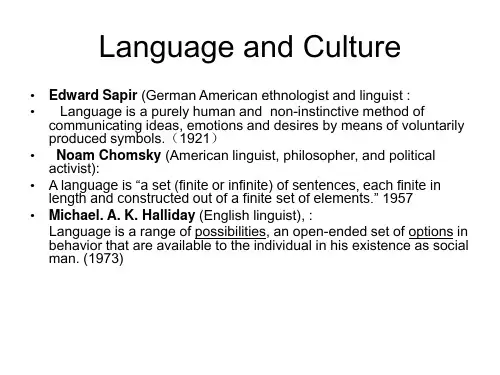
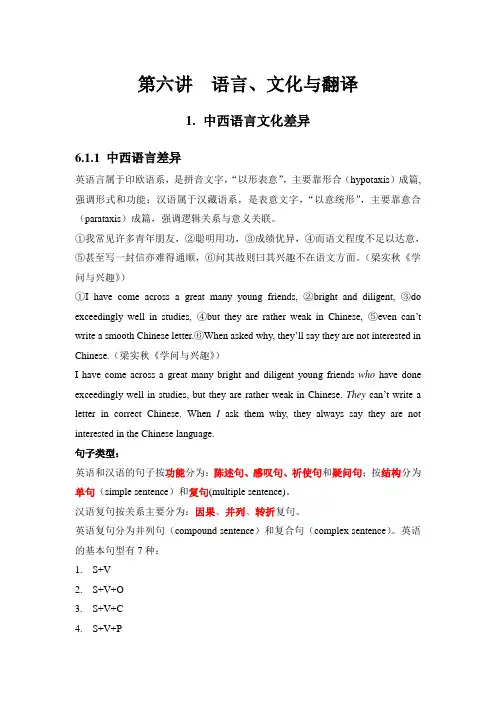
第六讲语言、文化与翻译1.中西语言文化差异6.1.1 中西语言差异英语言属于印欧语系,是拼音文字,“以形表意”,主要靠形合(hypotaxis)成篇,强调形式和功能;汉语属于汉藏语系,是表意文字,“以意统形”,主要靠意合(parataxis)成篇,强调逻辑关系与意义关联。
①我常见许多青年朋友,②聪明用功,③成绩优异,④而语文程度不足以达意,⑤甚至写一封信亦难得通顺,⑥问其故则曰其兴趣不在语文方面。
(梁实秋《学问与兴趣》)①I have come across a great many young friends, ②bright and diligent, ③do exceedingly well in studies, ④but they are rather weak in Chinese, ⑤even can’t write a smooth Chinese letter.⑥When asked why, they’ll say they are not interested in Chinese.(梁实秋《学问与兴趣》)I have come across a great many bright and diligent young friends who have done exceedingly well in studies, but they are rather weak in Chinese. They can’t write a letter in correct Chinese. When I ask them why, they always say they are not interested in the Chinese language.句子类型:英语和汉语的句子按功能分为:陈述句、感叹句、祈使句和疑问句;按结构分为单句(simple sentence)和复句(multiple sentence)。
![翻译通论第七章 文化与翻译[精]](https://uimg.taocdn.com/1600bc81b8f67c1cfbd6b850.webp)

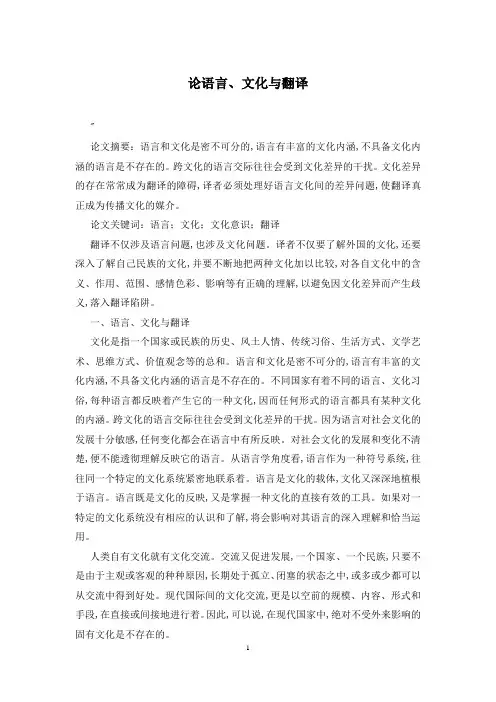
论语言、文化与翻译"论文摘要:语言和文化是密不可分的,语言有丰富的文化内涵,不具备文化内涵的语言是不存在的。
跨文化的语言交际往往会受到文化差异的干扰。
文化差异的存在常常成为翻译的障碍,译者必须处理好语言文化间的差异问题,使翻译真正成为传播文化的媒介。
论文关键词:语言;文化;文化意识;翻译翻译不仅涉及语言问题,也涉及文化问题。
译者不仅要了解外国的文化,还要深入了解自己民族的文化,并要不断地把两种文化加以比较,对各自文化中的含义、作用、范围、感情色彩、影响等有正确的理解,以避免因文化差异而产生歧义,落入翻译陷阱。
一、语言、文化与翻译文化是指一个国家或民族的历史、风土人情、传统习俗、生活方式、文学艺术、思维方式、价值观念等的总和。
语言和文化是密不可分的,语言有丰富的文化内涵,不具备文化内涵的语言是不存在的。
不同国家有着不同的语言、文化习俗,每种语言都反映着产生它的一种文化,因而任何形式的语言都具有某种文化的内涵。
跨文化的语言交际往往会受到文化差异的干扰。
因为语言对社会文化的发展十分敏感,任何变化都会在语言中有所反映。
对社会文化的发展和变化不清楚,便不能透彻理解反映它的语言。
从语言学角度看,语言作为一种符号系统,往往同一个特定的文化系统紧密地联系着。
语言是文化的载体,文化又深深地植根于语言。
语言既是文化的反映,又是掌握一种文化的直接有效的工具。
如果对一特定的文化系统没有相应的认识和了解,将会影响对其语言的深入理解和恰当运用。
人类自有文化就有文化交流。
交流又促进发展,一个国家、一个民族,只要不是由于主观或客观的种种原因,长期处于孤立、闭塞的状态之中,或多或少都可以从交流中得到好处。
现代国际间的文化交流,更是以空前的规模、内容、形式和手段,在直接或间接地进行着。
因此,可以说,在现代国家中,绝对不受外来影响的固有文化是不存在的。
跨文化的交流又必须通过翻译。
没有翻译,就没有跨文化交流。
各国、各民族之间的文化交流,既促进了各国、各民族自身文化的繁荣,也丰富了世界文化,促进了世界文明的发展。
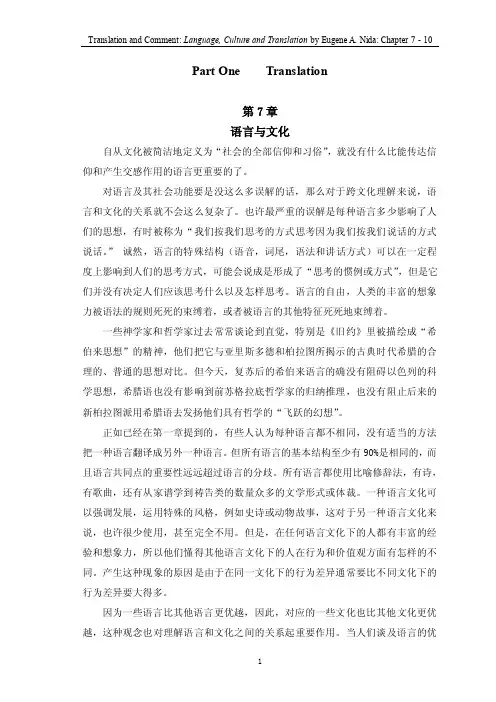
Part One Translation第7章语言与文化自从文化被简洁地定义为“社会的全部信仰和习俗”,就没有什么比能传达信仰和产生交感作用的语言更重要的了。
对语言及其社会功能要是没这么多误解的话,那么对于跨文化理解来说,语言和文化的关系就不会这么复杂了。
也许最严重的误解是每种语言多少影响了人们的思想,有时被称为“我们按我们思考的方式思考因为我们按我们说话的方式说话。
”诚然,语言的特殊结构(语音,词尾,语法和讲话方式)可以在一定程度上影响到人们的思考方式,可能会说成是形成了“思考的惯例或方式”,但是它们并没有决定人们应该思考什么以及怎样思考。
语言的自由,人类的丰富的想象力被语法的规则死死的束缚着,或者被语言的其他特征死死地束缚着。
一些神学家和哲学家过去常常谈论到直觉,特别是《旧约》里被描绘成“希伯来思想”的精神,他们把它与亚里斯多德和柏拉图所揭示的古典时代希腊的合理的、普通的思想对比。
但今天,复苏后的希伯来语言的确没有阻碍以色列的科学思想,希腊语也没有影响到前苏格拉底哲学家的归纳推理,也没有阻止后来的新柏拉图派用希腊语去发扬他们具有哲学的“飞跃的幻想”。
正如已经在第一章提到的,有些人认为每种语言都不相同,没有适当的方法把一种语言翻译成另外一种语言。
但所有语言的基本结构至少有90%是相同的,而且语言共同点的重要性远远超过语言的分歧。
所有语言都使用比喻修辞法,有诗,有歌曲,还有从家谱学到祷告类的数量众多的文学形式或体裁。
一种语言文化可以强调发展,运用特殊的风格,例如史诗或动物故事,这对于另一种语言文化来说,也许很少使用,甚至完全不用。
但是,在任何语言文化下的人都有丰富的经验和想象力,所以他们懂得其他语言文化下的人在行为和价值观方面有怎样的不同。
产生这种现象的原因是由于在同一文化下的行为差异通常要比不同文化下的行为差异要大得多。
因为一些语言比其他语言更优越,因此,对应的一些文化也比其他文化更优越,这种观念也对理解语言和文化之间的关系起重要作用。
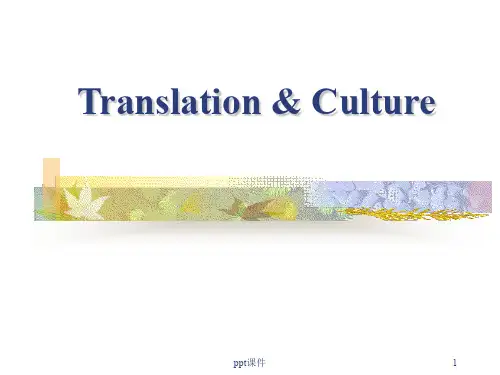

翻译除了单纯的文字转换以外,也是文化价值的一种传播途径,它要求翻译者从文化义的角度准确地再现原语所要传达的意义、方式及风格。
因此,翻译同语言和文化三者的关系非常密切。
语言,作为交流的一种工具,是文化传播的重要手段。
比如你和外国人交流,但是你的外文不行,同他人交流就有障碍,想表达的意思你不一定能表达清楚,对方的意思你也不一定听得明白。
所以作为一名翻译人员,前提是语言要好,至少在同他人交流中不出现沟通障碍。
另一方面,文化决定观念,观念决定行为。
和非母语的人或文字打交道,如果不了解译入语所在国家、地区的文化,那么就无法做到把原语的"形"、"神"在译入语中原计原味地体现出来。
本文中作者就针对这三者之间的关系,进行阐述和分析。
一、翻译与语言1 翻译的定义和目的首先,我们来看看中国和英国对于翻译的基本解释.《现代汉语词典》中,对于翻译一词的基本解释有两个:1一种语言文字的意义用另一种语言文字表达出来(也指方言与民族共同语、方言与方言、古代语与现代语之间一种用另一种表达);把代表语言文字的符号或数码用语言文字表达出来。
②做翻译工作的人。
因此,作为一名翻译,我们首先要明白什么是翻译,翻译的目的又是什么。
《剑桥高阶英语字典》中对于英语的解释为Something which is translated, or the process of translating something, from one language to another .从此处我们不难得知,翻译是一种语言的转换和传递,是指其行为和过程。
人类的主动行为都有其目的,翻译行为自然也不例外。
我国古代佛经译论家释道安在其《鞞婆沙序》中引用秘书郎赵正的一句话:“传胡为秦,以不闲方言,求识辞趣耳。
”这句话的意思是说:翻译就是要让不熟悉“非母语”的人也能够懂得其中的乐趣。
因此,翻译最原始的目的就是要让不懂得原文的读者或当事者通过翻译得知甚至欣赏原文的思想内容及其文体风格。

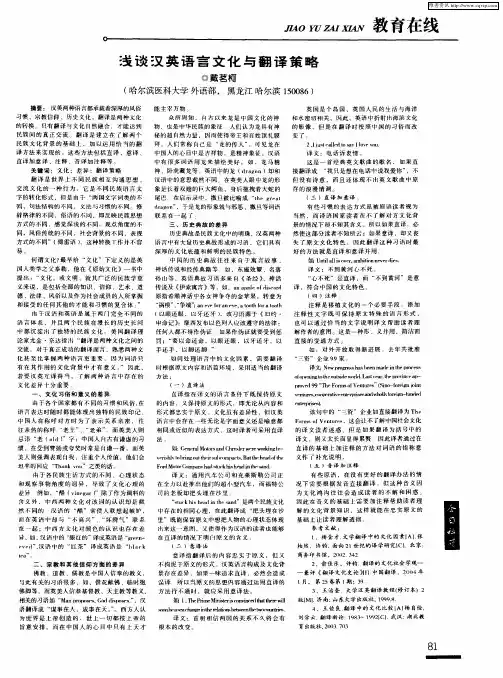
Language and CultureI firmly believe that language and culture are familiar with everyone on earth. Nevertheless, I don’t think everyone is clear about the real meaning of language and culture. On this basis, this essay will explain some basic information about language and culture, including what is language, what is culture and the relationship between language and culture. What’s more, quite a number of examples will be cited to help you have a better understanding of language and culture.Let’s begin with the concept of language. When we put a key word “language”into the online Wikipedia(维基百科),which is a free encyclopedia to people all over the world, we find that language is defined as the human capacity for acquiring and using complex system of communications , and a language is any specific example of such a system. From this definition, we have a clear consciousness towards language. When we look into the Oxford English-Chinese Dictionary, Language is divided into several meanings as follow:1. use of words in an agreed way as a method of human communications 2. system of words of a particular community or country etc. 3. faculty of speech 4. system of symbols and rules for writing computer programs 5. any method of communication.6. professional or specialized vocabulary. Besides, I have also learned the definition of language from my linguistics class. In the book A New Concise Course in Linguistics for Students of English(新编简明英语语言学教程). Langue is thought to be a system of arbitrary vocal symbol used for human communication. Short as it is, this definition has captured the main features of language. First of all, language is a system, that is, elements of language are combined according to rules. Second, language is arbitrary in the sense that theme is no intrinsic connection between a linguistic symbol and what the symbol stands for. This conventional nature of language is well illustrated by a famous quotation: A rose by any other name would smell as sweet. This quotation means rose is still rose even it is called by another name.For my part, the definition of language is varied. Generally speaking, it is a series code that facilitates human communication. And beyond a specific context, language has no intrinsic meaning.After finishing talking about what is language, let’s know more about culture. Similarly, in the Wikipedia, culture is defined as fallowing meanings, Firstly, culture is deemed as a modern concept based on a term first used in classical antiquity by the roman orator Cicero: Cultura animi ( cultiration of the soul). Secondly, the term “culture”in American anthropology had two meanings: the evolved human capacity to classify and represent experiences with symbol, and to act imaginatively and creatively. Thirdly, Hoebel describes culture as an integrated system of learned behavior patterns and which are not a result of biological inheritance. Besides, we learn the meaning of culture from theIntercultural Communication course. Culture is defined as the group of people who share the same ancestry. There are also many renowned socialists give culture several definitions. For example, E.sapir once said that culture may be defined as what a societu does and thinks.Shortly, culture is involved in so many aspects that it is hard to give it an accurate definition. Put in another way, for different people, culture has very different meaning, according to their own value, education background, social status and so forth. So there is nothing to criticize when other’s understanding of culture is different from yours.Having known so much basic information about language and culture, we will have look at the relationship between language and culture. In the book Intercultural communication in English(新编跨文化交际英语),there is a description of the relationship between language and culture. It goes like this: culture and language are intertwined and shape each other. Language is not a matter of neutral codes and grammatical rules. Each time we select words form sentences, and send a message, either oral or written. We also make cultural choices. We all agree that language helps in communication with people from different backgrounds. However, we may be less aware that cultural literary is necessary to understand the language being used. Personally speaking, language and culture is not two totally different subjects with no relevance. On the contrary, they are tightly related. That is to say, onlywhen language is put into a specific environment of cultural context does it have some real meaning.To have a better understanding of language and culture, several typical examples of the language and cultural difference between China and the western countries will be cited. We all know that the Chinese culture is both profound and extensive which leads to numerous idioms, allusions, proverbs and sayings, which is hard for foreigners to understand. Take some of them for instances. Firstly, take “过着牛郎织女的生活” for example, it can be literally translated as the Herd-boy and the spinning maid(mythical lovers separated by the Milky Way). But a foreigner may feel puzzled when look at this allusion, for they do not have the cultural background of the allusion. Actually, it is a folk tale of ancient China which means husband and wife living apart. If you want a foreigner fully understand this allusion, you’d better to tell him the whole tale, which also help him to know more about Chinese culture.There are also other four-character allusions in Chinese. Such as 三顾茅庐—make three calls at the thatched cottage(as Liu Bei did when he sought the aid of Zhuge Liang, a master straight then living in seclusion)—repeatedly request someone to take up a responsible post.完璧归赵——return the jade intact to the state of Zhao—return something to its owner in perfect condition.拔苗助长—stand by a stump waiting for hares to come and dash themselves against it—trust to chance and waiting forgains without pains.对牛弹琴—play music to an ox—cast pearls before swine.Most of the allusions come into being according to china’s long history. That’s why many foreigners find it hard to know comprehensively about Chinese language and culture. Nevertheless, there are some equivalents between these two different cultures. For example, in Chinese , there is an allusion called “画蛇添足” , in English, there is a similar proverb called gilding the lily. What’s more, it takes two to make a quarrel can be found in Chinese 一个巴掌拍不响. Hopefully, these make it easier to understand each other’s culture.In short, language in different cultures is hard to understand to most foreigners. The only thing to do is try one’s best to know more about each other’s culture, including all walks of life.。
语言文化与翻译作者:王天天来源:《剑南文学·经典阅读》2012年第11期摘要:本文简要将语言,文化,与翻译三者结合起来,阐述了它们之间不可分割的关系。
了解原语背景,领悟原语文化,严谨的翻译态度,缜密的翻译过程,是现代翻译不可或缺的条件。
关键词:背景,文化,翻译,语言中图分类号:H059 文献标识码:A 文章编号:1006-026X(2012)11-0000-01一、翻译程序翻译程序远非只是具体翻译某一文本时一步一步的过程,它还包括许多需要事先加以考虑的因素,如原语文本的性质,译者的能力、翻译过程的方向(如从习得语译成母语或反之)、译文所针对的读者类型。
实际翻译过程还包括与上述各方面截然不同的因素,如时限、个人翻译还是小组翻译、;理想的翻译程序还是切实可行的翻译程序。
二、原语文本原语文本和语篇一样,从抒情诗歌到装船通知,从国际条约到广告口号,种类繁多,由于常常需要翻译的语篇类型庞杂,因此,没有任何一种单一的翻译理论可以明确概括千差万别的体裁,并用一系列简明的原则规定如何处理每一种体裁的翻译,这是不奇怪的。
如果说没有一种语言理论能够解释语言的各种形式和功能,。
那么我们也就无法指望只有一种单一的翻译理论。
翻译活动不仅必须涉及各种题材,而且还涉及各种文体,如easy/difficult,serious/lighthearted,fresh/dull,Colorful/drab,exciting/boring。
语篇中的联想意义往往远比所指意义更重要,而文本上的这些差异则是大部分联想意义的基础。
人们讨论译者在翻译原语文本中遇到的问题时,往往只考虑文学体裁。
其实还有一些更为重要的特征,通称词汇和具体词汇的差异会造成一系列问题。
某些《圣经》的译者认为《启示录》中许多显圣使用了非常具体的词汇,因此很难翻译。
相反,他们认为《约翰福音》用的是通称词汇,所以翻译起来比较容易,然而实际情况恰恰相反,因为尽管种种显圣难以阐释,翻译起来还是相对要容易些,而恰如其分地翻译《约翰福音》中的通称术语确相当棘手,因为在英语和希腊语中这些词汇的意义相去甚远。